The world of prosthetics is changing fast. Just a few years ago, prosthetic limbs were mostly mechanical and rigid. Today, they are becoming smarter, lighter, and more lifelike. Engineers and scientists are working together to create prosthetics that not only look like real limbs, but also move and feel like them.
At Robobionics, we’ve seen how quickly technology is transforming lives. As we look ahead, it’s clear that the future of prosthetics is full of exciting possibilities. From artificial intelligence that learns how you walk, to materials that stretch and contract like muscles, the next generation of prosthetic limbs will offer more than just function—they will bring freedom, comfort, and control.
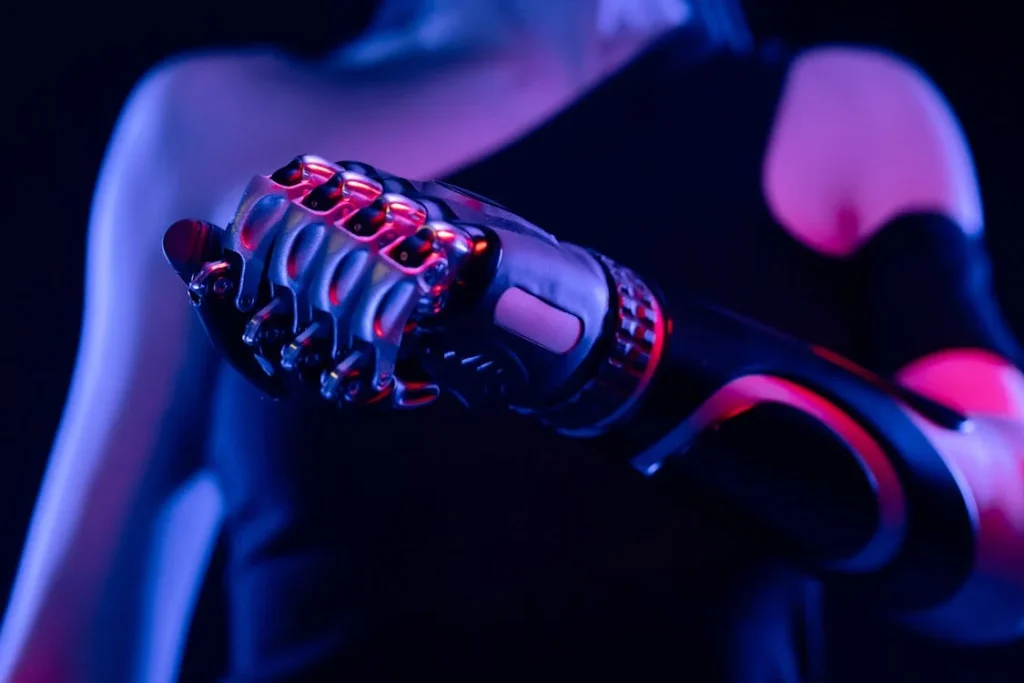
The Shift from Mechanical to Intelligent Prosthetics
How Traditional Prosthetics Worked
In the past, most prosthetic limbs relied on simple mechanical systems. These devices were built to replace the basic shape and function of a missing limb. A person could move them using body strength, levers, or cables.
While they offered support and a degree of mobility, they often felt unnatural. Many users had to work hard just to do simple tasks like holding a cup or walking steadily.
These older systems didn’t adjust to different situations. For example, walking on stairs or uneven ground required extra effort and balance.
The prosthetic didn’t “know” what the user was doing—it simply followed basic motions, sometimes with the help of muscle contractions or body weight shifts.
The Need for Better Solutions
The human body is extremely complex. It adjusts constantly based on our surroundings. Our muscles, joints, and nerves work together every second.
A rigid prosthetic, no matter how strong, couldn’t match this natural movement. Users often felt limited. Some even gave up on using their prosthetic altogether.
To solve this, engineers and medical experts began looking at how the body moves and reacts.
They started designing prosthetics that could do more than just mimic shape—they wanted devices that could think and respond like a part of the body.
Artificial Intelligence: Teaching Prosthetics to Think
Smarter Movement Through Learning
Artificial Intelligence (AI) is playing a big role in the future of prosthetics. Instead of moving the same way every time, new AI-powered prosthetics can learn how a person walks, runs, or uses their hand.
Over time, the prosthetic becomes more responsive. It can even adjust on its own based on what you’re doing or where you are.
Imagine a leg prosthetic that senses you’re walking uphill and changes how it moves. Or a hand that understands how much pressure to use when holding a ripe fruit versus a heavy object.
These aren’t dreams anymore—they’re becoming reality.
Sensors and Real-Time Feedback
AI needs data to work. That’s where sensors come in. New prosthetic limbs are packed with small sensors that collect information in real time.
These sensors track pressure, angle, speed, and even muscle signals from the remaining limb. The AI uses this data to make instant adjustments.
The result is smoother, more natural movement. Users don’t have to think twice about how they move—the prosthetic does the thinking for them.
Muscle-Mimicking Design: A Leap Toward Natural Movement
Moving Beyond Motors and Hinges
Another big change is happening in the materials and structure of prosthetics. Traditional designs use motors and hinges, which work well but can feel robotic.
New designs are inspired by how real muscles and tendons move. These next-generation prosthetics stretch, bend, and react more like a human limb.
This approach is called biomimicry—designing technology to behave like natural systems. Researchers are using soft materials that flex and return to shape, just like muscles.
They’re also working with smart materials that respond to heat or electric signals. These materials can contract or relax, helping the prosthetic move more smoothly.
Better Control Through Myoelectric Signals
Another exciting development is the use of myoelectric signals. These are tiny electric signals your muscles make when they contract. Advanced prosthetic arms and hands can read these signals through sensors placed on the skin.
When you think about moving your hand, your remaining muscles send out signals. The prosthetic picks them up and acts—often in a split second.
This technology allows for very fine control. Users can do things like grip a fork, pick up a coin, or even tie their shoes. And as the technology improves, the movement becomes even more natural and precise.
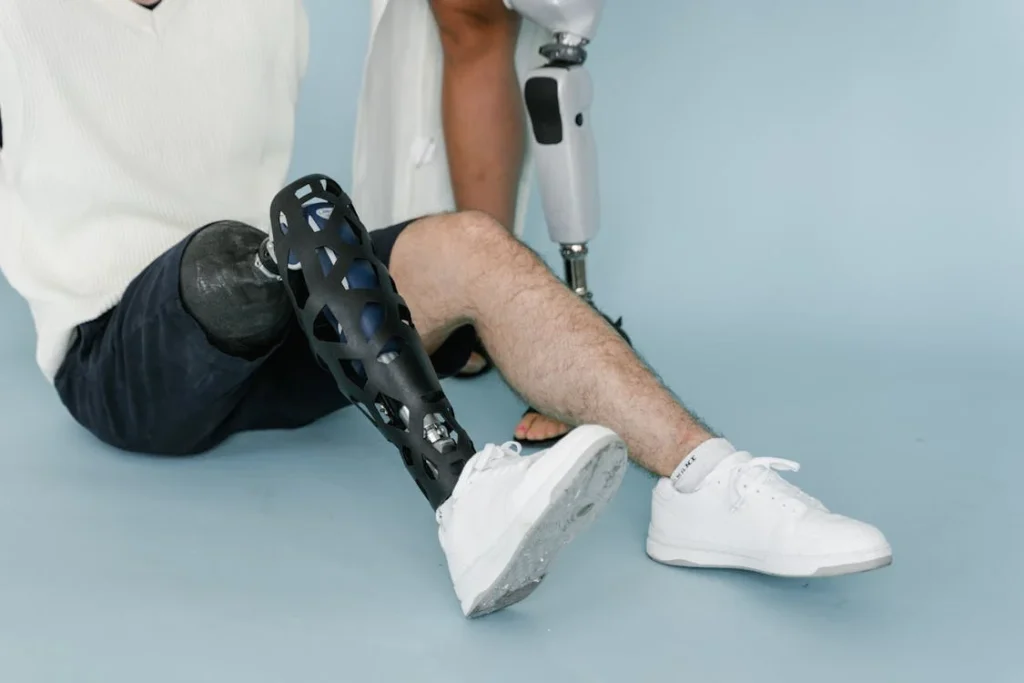
Smarter Materials, Softer Limbs
The Rise of Flexible, Responsive Materials
Until recently, many prosthetic limbs were made from metals, plastics, or carbon fiber. These materials are strong and lightweight, but they don’t move like real limbs. That’s where soft robotics comes in.
Soft robotics uses materials that stretch, twist, and bend like skin and muscle. These materials respond better to the body’s movement and feel more natural when worn.
Some even adjust their shape in real time, offering a custom fit and more comfort throughout the day. Instead of stiff hinges, soft prosthetics move fluidly, more like our own muscles and joints.
Researchers are exploring materials that can sense pressure and temperature. These “smart skins” give users feedback about their surroundings—how hard they’re gripping something or if a surface is hot or cold.
These kinds of responses help people trust their prosthetic more and feel more in control.
Lightweight, Yet Durable
Comfort is key to wearing a prosthetic all day. New materials are not only flexible, but also incredibly light.
Advanced polymers and 3D-printed structures reduce the weight of a limb without compromising its strength. Some of these designs are so precise that they can be made to match the user’s body exactly.
For example, 3D scanning can capture the exact shape of a person’s remaining limb or stump. This data is then used to print a socket or support that fits like a glove.
A better fit means less skin irritation and fewer adjustments. The prosthetic becomes an extension of the body, not just a tool.
Brain and Nerve Interfaces: The Next Big Leap
Direct Communication with the Nervous System
One of the most exciting developments in prosthetic technology is the ability to connect devices directly to the nervous system.
In the past, prosthetics responded to muscle signals on the surface of the skin. Now, researchers are going deeper—into the nerves and even the brain.
With these interfaces, a user’s thoughts can control the movement of a prosthetic. If you think about closing your hand, your brain sends a signal to the limb—and it responds instantly.
This kind of direct control opens the door to more precise and natural motion.
It also allows for two-way communication. In the future, not only will you control the prosthetic, but it will also send feedback to your brain.
That means you could feel the shape, texture, or temperature of something you touch with your bionic hand.
Real-World Applications Are Growing
Some of this technology is still in the research stage, but trials are already happening. In certain cases, surgeons implant small electrodes around the nerves or into muscles.
These electrodes pick up signals and send them to the prosthetic. The user can then control the limb with very little effort.
Other systems use tiny chips or sensors in the brain itself. These brain-computer interfaces (BCIs) are more complex but offer amazing potential.
People with spinal cord injuries or missing limbs could regain full control of movement just by thinking.
Although these systems are still being tested, the results are promising. They offer a glimpse into a future where prosthetic limbs respond as quickly and smoothly as natural ones.
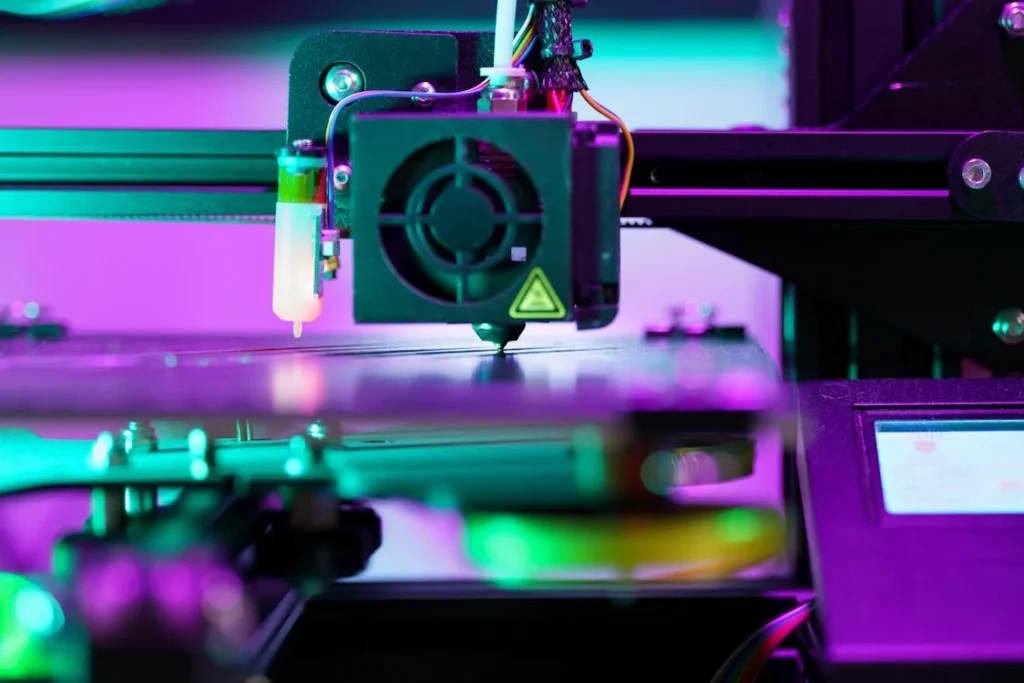
Personalized Design with 3D Printing
Customization Made Fast and Affordable
Every person’s body is different. A one-size-fits-all prosthetic rarely works well. That’s why customization is so important. 3D printing has made it possible to create fully personalized limbs faster and at a lower cost than traditional manufacturing.
Using 3D scanning, the exact measurements of a person’s limb can be captured. This information is then used to print parts that match the user perfectly.
Whether it’s the socket that connects the limb, or the entire outer structure, 3D printing allows for unmatched accuracy and comfort.
At Robobionics, we’ve seen how powerful this technology can be. It helps us provide better care faster, especially in areas where access to traditional prosthetics is limited.
A well-fitted prosthetic not only feels better, but also works better, giving users more control and reducing fatigue.
Faster Prototyping for Innovation
3D printing also speeds up the development of new prosthetic designs. Engineers can test different ideas quickly, changing shapes, materials, or features without building a whole new prototype from scratch.
This flexibility means new innovations reach users faster.
As materials improve and printers become more advanced, 3D-printed prosthetics will become even more durable and functional.
Soon, users may be able to choose from a range of features—like grip strength, color, and movement style—and have their ideal limb printed in a matter of days.
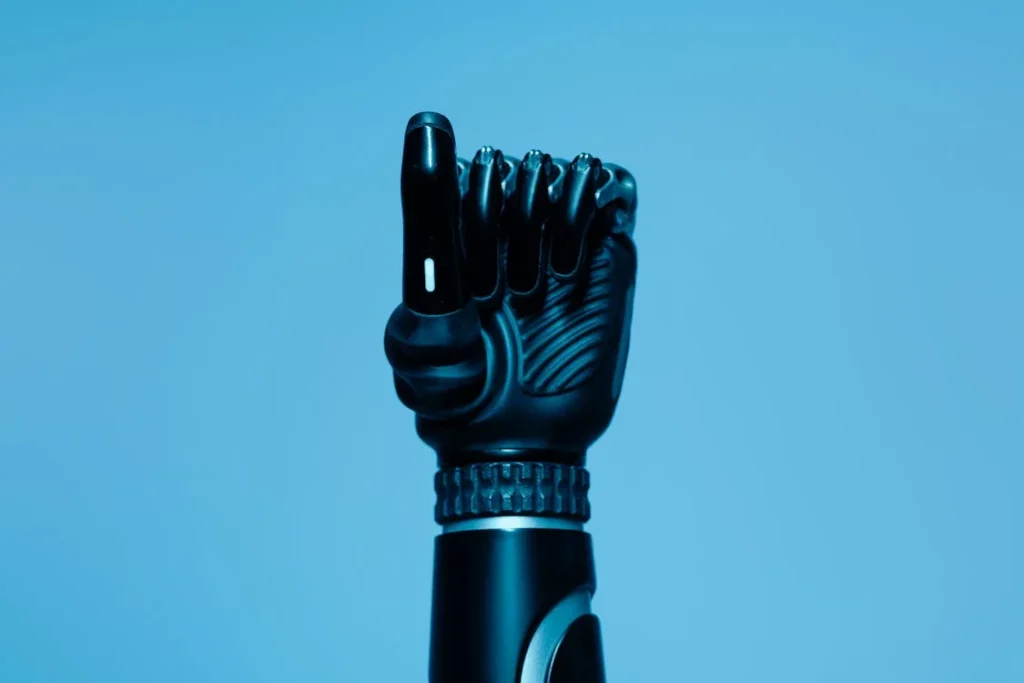
Designing for Humans, Not Just for Function
Comfort and Confidence Matter Just as Much
In the early days of prosthetics, the main goal was utility—just helping someone walk or pick up something again.
But over time, we’ve learned that comfort, emotional well-being, and how a person feels about their prosthetic are just as important as how it functions.
Today’s designers are thinking beyond joints and motors. They’re asking, “How does it feel to wear this all day?” or “Does this make the user feel more confident in public?” These are the real questions that drive innovation now.
When a prosthetic fits well, moves naturally, and looks good, users are more likely to use it regularly. It becomes a part of them, not just a device.
Materials that feel smooth on the skin, sockets that reduce sweat buildup, and limbs that match skin tones or personal style—these aren’t small details.
They change how people interact with the world. More importantly, they help restore self-esteem.
Form and Function Together
Good design blends form and function. That’s why today’s prosthetic limbs often look sleek, modern, and even futuristic. But they aren’t just pretty—they are built to perform under pressure.
For example, robotic hands now have streamlined designs with fingers that move like natural joints.
Advanced leg prosthetics can include knee sensors and spring-like feet that absorb shock. Each detail is chosen to support both movement and comfort.
Many users today even take pride in the design of their limbs. It’s no longer about hiding a disability—it’s about owning it. And this change in attitude is as powerful as any motor or sensor.
Rehabilitation That Fits Into Real Life
Bringing Therapy Home
Once someone receives a prosthetic, their journey is far from over. Learning to use it well takes time, patience, and support. That’s where rehabilitation comes in.
But traditional rehab—visiting a clinic several times a week—can be hard for many people. Travel costs, limited access to specialists, and packed schedules often get in the way.
Now, a new trend is making life easier: home-based rehabilitation using smart, gamified tools.
Users can now train with their prosthetic at home, at their own pace, using simple apps and devices that turn practice into a game.
For example, a hand prosthetic might come with an app that lets the user “catch” virtual objects by practicing gripping and releasing. Or a leg prosthetic might have a walking tracker that sets daily challenges.
These tools make therapy more engaging and fun, and that encourages users to stick with it.
The Power of Feedback and Progress Tracking
Rehabilitation isn’t just about exercise—it’s about learning what works and what needs improvement. Smart prosthetics now come with built-in sensors that track how the device is being used.
This data is shared with therapists, who can then guide the user more effectively.
Users also benefit from seeing their own progress. Imagine an app that shows how your grip strength has improved over two weeks or how much smoother your gait has become.
These small victories can be incredibly motivating.
At Robobionics, we believe this kind of feedback empowers people. It puts control back in their hands, allowing them to feel involved and confident in their journey.
With more tools like this, rehabilitation is becoming less of a burden and more of an empowering experience.
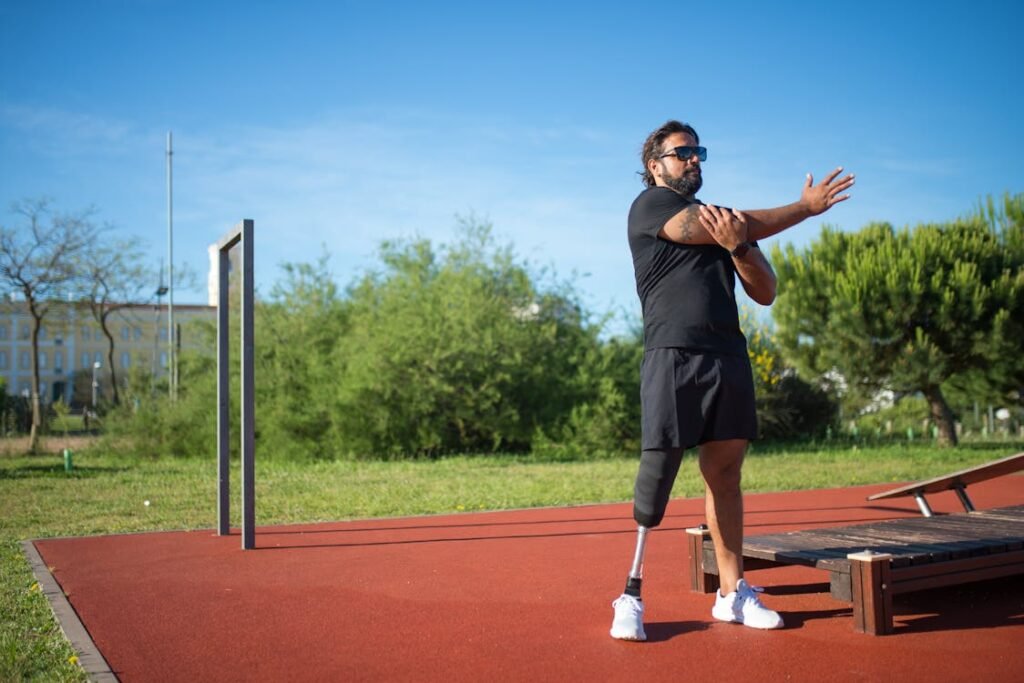
Accessibility and Affordability: Breaking Down Barriers
Local Solutions That Make a Big Impact
High-tech prosthetics used to be something only available in a few countries, for a few people. The cost was high, the service was slow, and repairs could take months.
That’s changing. Local innovation, especially in places like India, is helping break those barriers.
At Robobionics, we’re proud to see how Indian-designed and manufactured prosthetics are changing lives here at home.
By using local materials, 3D printing, and a network of partner clinics, we make prosthetics more affordable and accessible. Users don’t have to wait months or pay massive fees for service—they can get help close to home.
This shift is especially important in rural and underserved areas. When technology is made with the local user in mind, it works better.
And when support is nearby, people are more likely to keep using their prosthetic—and to live more independently.
The Role of Public Health and Policy
Government policies are also starting to support wider access. Subsidies, insurance coverage, and disability rights laws are all helping more people get the care they need.
Organizations and CSR-driven initiatives are stepping in too, donating limbs or funding prosthetic programs in schools, villages, and workplaces.
But there’s still work to do. Many people remain unaware of the options available. Education, outreach, and advocacy are key.
As a community, we must ensure that every person who needs a prosthetic knows how to get one, and how to use it well.
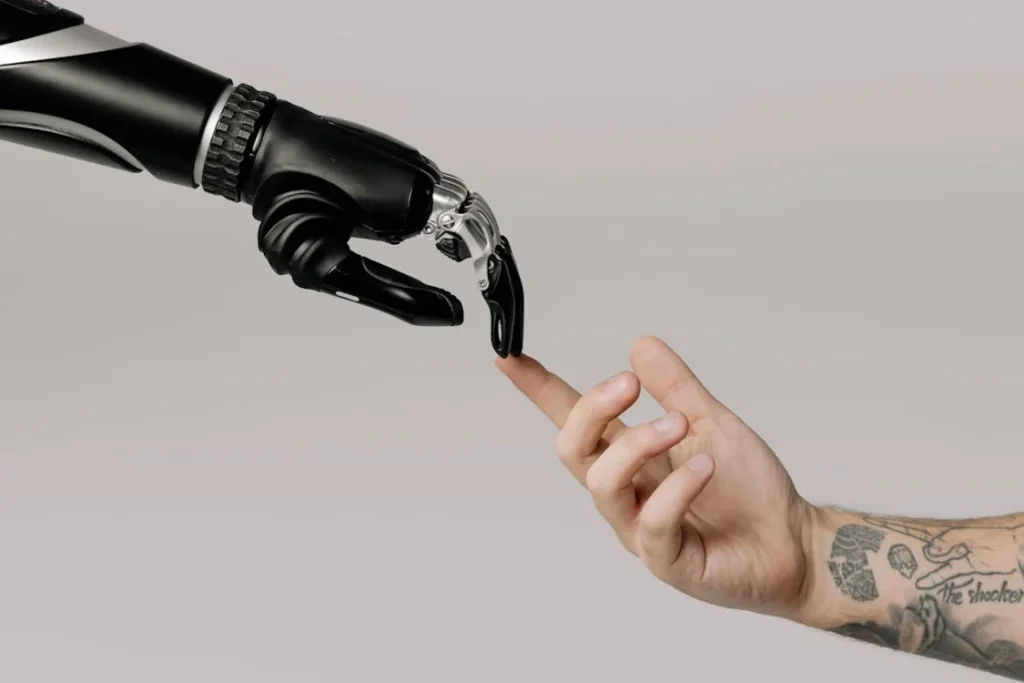
The Road Ahead: Where Biomechanics and Humanity Meet
A Future Built Around People
The future of prosthetics is not just about better machines. It’s about creating solutions that put people first—solutions that adapt to real life, support daily goals, and restore both movement and dignity.
We are moving toward a world where prosthetic limbs are not only smarter but also more personal. They will be designed for how people live, how they work, and how they want to express themselves.
This shift toward human-centered prosthetics is not a distant dream. It’s already happening. With each new innovation, users are gaining more control, more comfort, and more confidence.
Whether it’s a hand that can type on a phone screen or a leg that adjusts on its own to slippery surfaces, these changes are helping people move forward with more independence than ever before.
Integrating Prosthetics Into the Body’s Natural Flow
The most exciting possibility is full integration—where prosthetics become so responsive that they behave like real limbs. With brain interfaces, nerve sensors, and AI learning systems, this future is becoming real.
A user might not just move a prosthetic with ease but also feel with it, interact with others through touch, and adjust to new tasks automatically.
These systems may one day become part of standard care for amputees, just like getting a cast for a broken arm.
What’s remarkable is that this technology will not just be high-end or luxury—it will be built to scale, affordable, and accessible through partnerships, public health networks, and socially responsible manufacturing.
As these tools evolve, the line between biology and technology will continue to blur. Prosthetics won’t be seen as replacements anymore. They’ll be seen as extensions—of the body, of the mind, and of a person’s identity.
Collaboration Across Fields
The Role of Engineering, Medicine, and Design
Making this future real takes teamwork. Engineers, doctors, therapists, and designers are now working side-by-side.
Together, they are combining biomechanics with neuroscience, materials science, and user feedback to create truly life-changing products.
Every field brings something unique. Engineers understand structure and motion. Medical professionals know how the body works and heals.
Designers bring comfort, beauty, and ease of use. And most importantly, users themselves help shape the direction by sharing what works and what doesn’t.
At Robobionics, we work with this kind of collaboration every day. It’s what allows us to constantly improve.
We take every challenge and turn it into a learning moment—refining each product until it feels right, works better, and gives people what they really need.
The Importance of Listening to Users
The most important voice in the future of prosthetics is not that of the engineer or the researcher. It’s the user. Their experience, their day-to-day needs, and their dreams guide where technology should go.
That’s why more prosthetic companies are including users early in the design process. Whether it’s testing prototypes, giving feedback on comfort, or suggesting features they’d like to see, users are helping shape the next generation of biomechanical limbs.
Listening closely also helps companies build better relationships and trust. When users feel heard and valued, they’re more likely to use the technology, stick with rehabilitation, and become advocates in their own communities.
Conclusion
The future of prosthetic biomechanics is not just about smarter technology—it’s about creating solutions that truly work for people. From AI that adapts to your movements, to muscle-mimicking designs that feel like a natural part of you, innovation is moving us toward more human, more empowering prosthetic experiences.
Advances in materials, brain interfaces, and home-based rehabilitation are helping users live with greater comfort, control, and confidence. What once felt robotic is now becoming fluid, intuitive, and deeply personal.
As a community of designers, engineers, and healthcare professionals, our responsibility is clear: build prosthetics that not only restore motion, but also dignity. At Robobionics, we’re proud to be part of this journey—pushing the boundaries of what’s possible, while staying rooted in empathy and purpose.
The future is not just in the lab—it’s in the hands, steps, and stories of people who live it every day.



